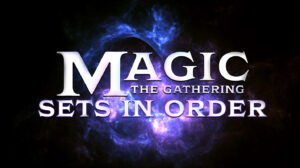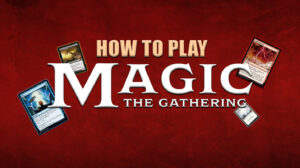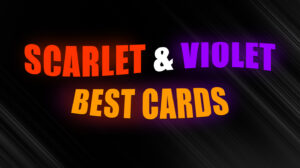10 Best MTG Cards in 2025: Power, Value, History
Eneba Hub contains affiliate links, which means we may earn a small commission if you make a purchase through them—at no extra cost to you. Learn more
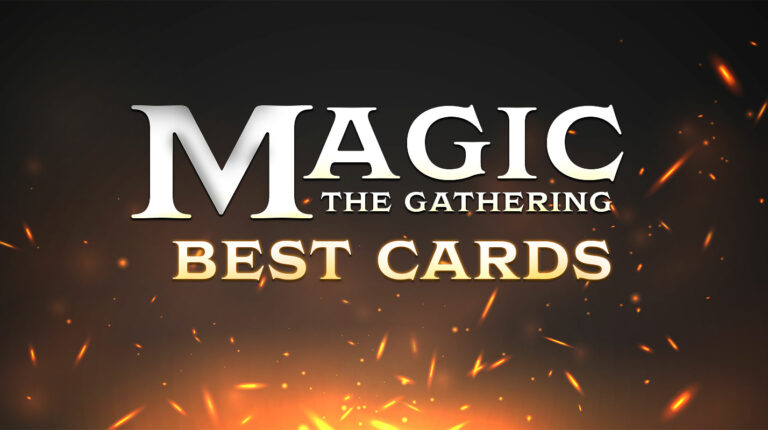
Looking for the best MTG cards is always an incredible challenge. There are so many criteria that a “best” card must pass through, and everyone has their own rubric for calling a card great.
Now it’s my turn to take a pass at what I think are the best MTG cards currently available.
This list is going to have a bit of everything for everyone: broken planeswalkers, historic (if not particularly useful) singles, frequently-reprinted staples, and more!
Jump to:
Our Top Picks for MTG Cards
To try and diversify this list, I ran cards through a bunch of different criteria – formats, raw power, historical value, or collector’s value – and tried not to be too redundant. And while favorites like Demonic Tutor, Arcane Denial or Arcane Signet might be obvious picks, they didn’t luck out on this random roll. Maybe another time; as I said, the card pool is biblically humongous.
I did, however, try to keep five of the most powerful and relevant cards at the top of the list, due to their value (in terms of gameplay, affordability, and availability). These cards are:
- Oko, Thief of Crowns – breaking the format? Please. Breaking the entire game, more like.
- Gaea’s Cradle – a very powerful card, if you can afford it.
- Sol Ring – a 1-cost for CC. Simple and hilariously strong.
Note that this list assumes some level of familiarity with the game. So, if you haven’t learned how to play Magic: The Gathering yet and are just shopping around, you may want to brush up to make this list more readable!
Now, without further ado, let’s have a look at the list!
Best MTG Cards Roundup For Seasoned and New Players
Magic: The Gathering has something for everyone – intense duels for competitive players and fun, accessible formats for newcomers.
This roundup highlights the best MTG games to enjoy, no matter your experience level.
1. Oko, Thief of Crowns
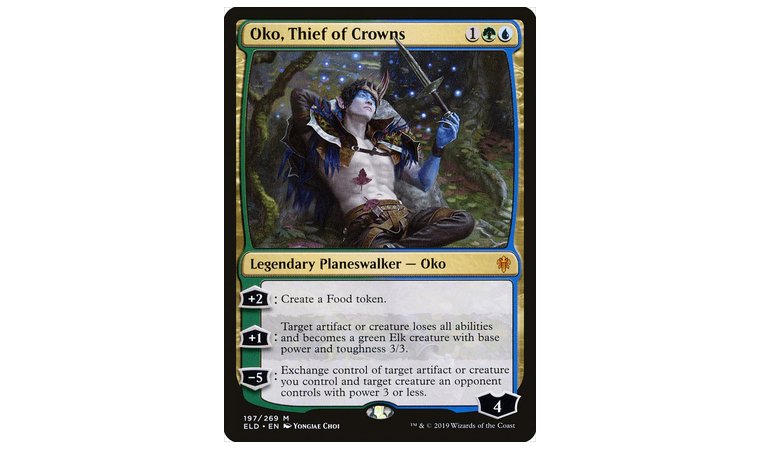
| Card Type | Legendary Planeswalker – Oko |
| Mana Cost | 1GB |
| Effects | +2: Create a Food token.+1: Target artifact or creature loses all abilities and becomes a green Elk creature with base power and toughness 3/3.-5: Exchange control of target artifact or creature you control and target creature an opponent controls with power 3 or less. |
| Loyalty Counters | 4 |
| Set | Throne of Eldraine |
| Restrictions/Special Notes | Banned in all except Commander and Vintage. |
Oko, Thief of Crowns is a stupidly broken yet deceptive planeswalker, which is quite fitting for the whole fairytale aesthetic that Throne of Eldraine had going on. This one card checked so many others that he was quickly banned; currently, he’s only available in Commander and Vintage, where his power is kept in check by other crazy sets.
Let’s talk about Oko’s abilities. For +2, Oko can create a Food token. Food by itself isn’t a great mechanic – but remember that it counts as an Artifact, giving Oko surprising synergy. His ultimate, which isn’t usually relevant, lets you swap cards with your opponent.
The real star of the show is Oko’s +1. Once per turn, Oko turns a target artifact or creature into a 3/3 green elk. There’s a ton of applications for this: you can elk your own cards once you’re done with their effects, you can elk the Food token he makes, and best of all, you can elk your opponent’s big creatures and artifacts – essentially making Oko a persistent answer to that your opponent will need to play around. Oh, and elking isn’t a destruction effect, meaning that very few (if any) protective layers will prevent it.
One final reminder: this is a +1, so it’s not only removal, but Oko becomes tougher to kill with each elk. Either burst him down when he hits the field, or just accept that you’re playing a green elk deck now.
2. Gaea’s Cradle
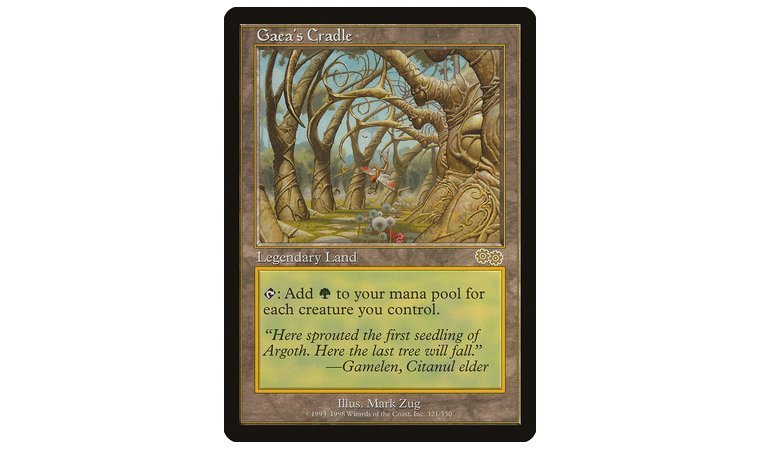
| Card Type | Legendary Land |
| Mana Cost | N/A |
| Effects | Tap: Add G for each creature you control. |
| Set | Urza’s Saga |
| Restrictions/Special Notes | Is on the Reserved List. |
Gaea’s Cradle is a simple card that speaks for itself.
At zero cost to yourself, you tap it and gain G per creature you control. There are a ton of ways to maximize the mana generation of this card (cough elves), and the massive mana income you get from Gaea’s Cradle can be used to fuel your swarm or to bring out big spells or giant monsters that green loves so much.
The earlier Gaea’s Cradle comes into play, the more mana it yields: on turn 1, it’ll produce 1 mana, but starting from turn 2, its value scales depending on how quickly you can flood the field, and by turn three, you’re looking at an income of maybe four mana or higher! Oh, and one interesting thing to note: Gaea’s Cradle doesn’t care about the color of the creatures you control.
Gaea’s Cradle commands a super expensive price tag not just because of its power, but its real-life rarity – it’s on the Reserved List, meaning it will never ever be reprinted. The good news is that this price is pretty stable!
3. Sol Ring
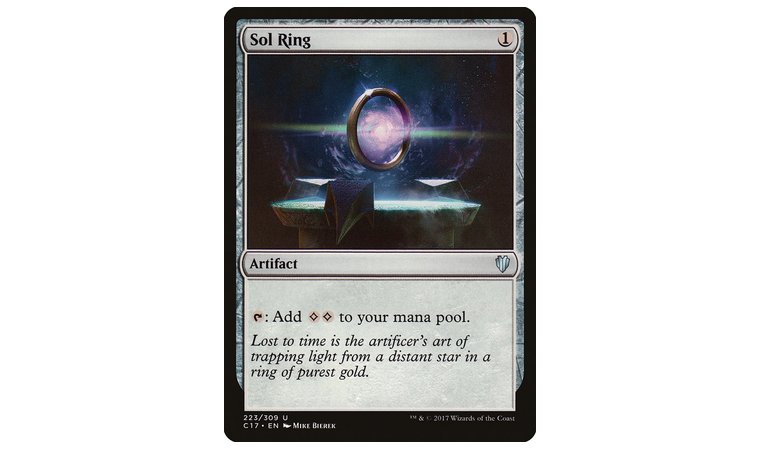
| Card Type | Artifact |
| Mana Cost | 1 |
| Effects | Tap: Add CC. |
| Set | Multiple, most recent reprint is in Aetherdrift Commander. |
| Restrictions/Special Notes | Banned in all except Commander and Vintage; restricted in Vintage. |
Sol Ring is another card that nakedly displays its power. It’s so ubiquitous that it’s banned in every format except Commander (it’s a key piece in the best Commander decks) and Vintage, where it’s restricted to just one copy. For good reason.
So, a quick analysis: for 1 mana, you can put this card into play, and it can be tapped to gain CC (two colorless mana). A short, sweet, and utterly devastating effect with a myriad of applications. But explosive first turns isn’t the only thing this card can do. As with fellow mana generator Gaea’s Cradle, Sol Ring’s value scales sharply with how long it gets to exist on the field, and having a reliable non-land source of 2 colorless mana every turn offers amazing value. In some cases, it can even be more powerful than the Moxes!
Lastly, despite all this power, Sol Ring is both affordable and easy to find!
4. Swords to Plowshares
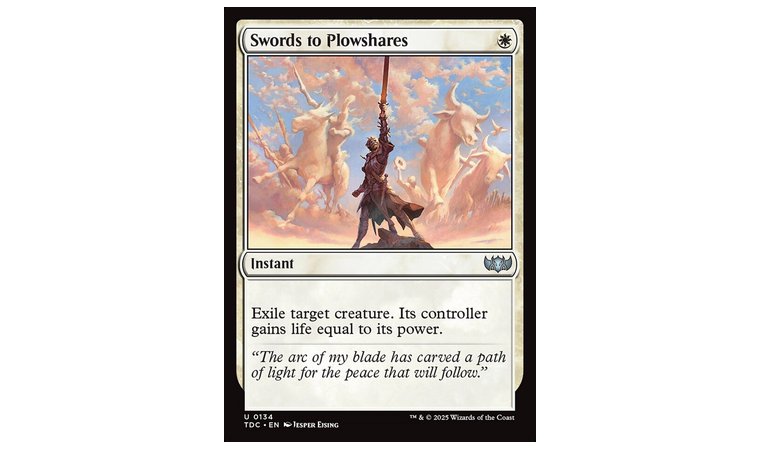
| Card Type | Instant |
| Mana Cost | W |
| Effects | Exile target creature. Its controller gains life equal to its power. |
| Set | Multiple, most recent reprint is in Tarkir: Dragonstorm Commander. |
| Restrictions/Special Notes | None |
Once again, we have another card that doesn’t even try to hide how powerful it is. For the low, low cost of W, Swords to Plowshares exiles a target creature and its controller gains life equal to its power. This would be a good enough effect on its own, but take note: Swords to Plowshares is an instant, meaning that it can also be used offensively to interrupt your opponent’s key plays.
Now, on to the life side gain part of the card, which tends to trip up new players. Most veteran players will know this, but in card games with a life value, gaining life is not as important as spending it. In the vast majority of games, the life that your opponent gains from you nuking their creatures with Swords to Plowshares will not amount to much, unless they’re playing a black deck with life-to-resource cards (watch out for Toxic Deluge or worse, Yawgmoth’s Bargain!)
Swords to Plowshares isn’t a particularly expensive card, and it’s very easy to find. Its ease of use, low cost, and incredible effect ensure it a place in even the best decks.
5. Craterhoof Behemoth

| Card Type | Creature – Beast |
| Mana Cost | 5GGG |
| Power/Toughness | 5/5 |
| Effects | Haste When this creature enters, creatures you control gain trample and get +X/+X until end of turn, where X is the number of creatures you control. |
| Set | Multiple, most recent reprint is in Tarkir: Dragonstorm. |
| Restrictions/Special Notes | None |
Green is the master of unga bunga Magic, and Craterhoof Behemoth’s reprint in Tarkir: Dragonstorm serves to reinforce that. If you’re looking for the perfect capstone for a green swarm deck, this card should definitely be in your sights.
Despite its imposing appearance (and transition from toad-thing to mammoth), Craterhoof Behemoth has a frankly terrible power/toughness to mana cost ratio. Where it does shine is how it buffs all your guys – elves, take note – by giving them not only trample, but also +X/+X, where X is the number of creatures you control. This is usually enough damage for game: just 2 2/2 creatures plus Craterhoof Behemoth (haste, remember) already adds up to 18 trample damage – enough to finish off a slightly-damaged opponent.
Do note that as an endgame piece, Craterhoof Behemoth comes with a very steep cost (5GGG), so you may want mana generation cards to catch your opponent off-guard before the 8th turn. You’re spoiled for choice when it comes to mana generators, though!
6. Gilded Lotus

| Card Type | Artifact |
| Mana Cost | 5 |
| Effects | Tap: Add three mana of any one color. |
| Set | Multiple, most recent reprint is in Magic: The Gathering Foundations. |
| Restrictions/Special Notes | None |
Now, to one of the more contentious entries on this list. Gilded Lotus is yet another card that generates mana on your turn.
But unlike the other mana generators on this list, Gilded Lotus comes in much later in the game due to its 5 mana cost, and thus doesn’t contribute to the early game. Even with ramp cards like Three Visits, you’re looking at a best-case scenario of getting Gilded Lotus on turn 3, which will very likely telegraph to your opponent that you’re looking to play big cards early, thus giving them space to counter your plays.
Gilded Lotus is really, really good in the right circumstances, but its high mana cost means that you have to carefully consider if you really need the big mana income that Gilded Lotus offers.
You’ll have to ask yourself some questions: are you willing to give up early field control to bring out Gilded Lotus early, can you stall for five turns without losing, and do you have a powerful high-cost card that can swing the game in your favor if you can cheat it out early? If the answers to all these questions are yes, then go ahead and add Gilded Lotus in your deck.
7. Mox Amber
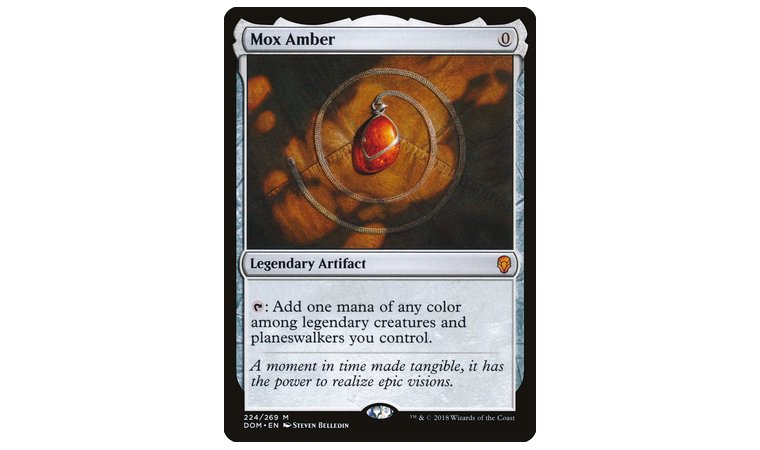
| Card Type | Artifact |
| Mana Cost | 0 |
| Effects | Tap: Add one mana of any color among legendary creatures and planeswalkers you control. |
| Set | Dominaria, most recent reprint is in The Brothers’ War Retro Artifacts |
| Restrictions/Special Notes | None |
Yeah, it’s a Mox, but Mox Amber is part of the “balanced” Moxes that were deliberately made trickier to use so as to not make them auto-includes. And as with Gilded Lotus, Mox Amber’s deckbuilding value fluctuates, and it serves a very specific niche.
This mana generator’s value depends on whether or not you have enough legendaries to maximize its mana income.
Mox Amber’s effect is simple: tap it to gain one mana of any color, so long as you have a legendary creature or planeswalker of that color; its low cost and scaling with the number of legendaries means that ideally, you should play Mox Amber as early as possible.
However, Mox Amber’s use is restricted by your deck of choice. Ask yourself, “do I have enough 1 or 2 cost legendaries that I want to play as early as possible?”. If the answer is yes, then you might want to include this card. As I said earlier, it’s tricky to work around, especially since not every low-cost legendary meshes with your overall strategy!
Uniquely, Mox Amber’s position is also dependent on the current card pool. If Wizards of the Coast decides to print must-have 1 cost legendaries in the next set, it might be time to get a Mox Amber of your own.
8. Teferi, Temporal Pilgrim
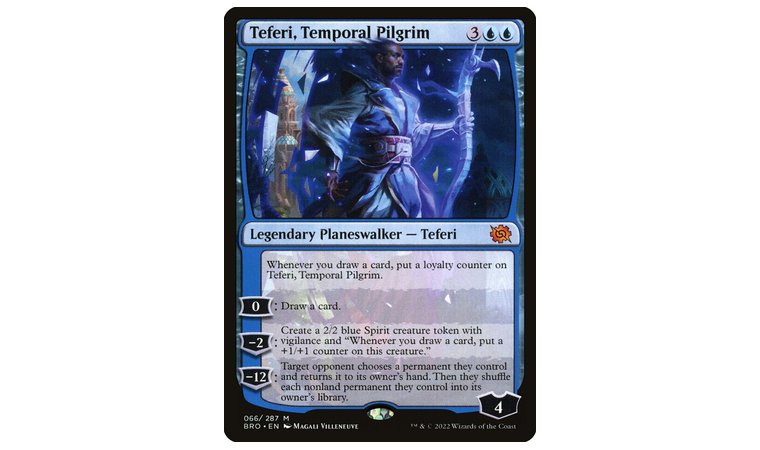
| Card Type | Legendary Planeswalker – Teferi |
| Mana Cost | 3UU |
| Effects | Whenever you draw a card, put a loyalty counter on Teferi. 0: Draw a card.-2: Create a 2/2 blue Spirit creature token with vigilance and “Whenever you draw a card, put a +1/+1 counter on this token.”-12: Target opponent chooses a permanent they control and returns it to its owner’s hand. Then they shuffle each nonland permanent they control into its owner’s library. |
| Loyalty Counters | 4 |
| Set | The Brothers’ War |
| Restrictions/Special Notes | None |
Despite his relatively high cost of 3UU, Teferi, Temporal Pilgrim offers a ton of utility that plays well in a ton of blue decks, making him a great centerpiece for any player who wants to control the board.
Teferi is unique in how he generates loyalty counters. Other planeswalkers have an ability that increases their counters, but Teferi only has a 0, a -2, and a -12. Instead, Teferi comes with a nifty passive that nets him loyalty counters when you draw cards. And it’s not like blue has any way to gain additional card income…right?
Let’s get to his abilities. For no loyalty counters, Teferi can draw you a card. It’s…not much, and with blue’s massive card draw pool, making this a mediocre option that you only play if you can’t do anything else. Teferi, Temporal Pilgrim’s second ability is a token generator; for -2, he spawns a 2/2 Spirit with vigilance that also ramps up alongside him whenever you draw cards.
His ultimate, which costs 12 counters, is effectively a board wipe and can lead to a swift victory – though do make sure you can swing for lethal before activating it.
I must warn you that there are blue planeswalkers (Jace, the Mind Sculptor, in particular) that come into play much earlier and provide a ton of value. As always, do your research: analyze your deck and ask yourself if Teferi offers you something that your other cards can’t!
9. Ivory Tower

| Card Type | Artifact |
| Mana Cost | 1 |
| Effects | At the beginning of your upkeep, you gain X life, where X is the number of cards in your hand minus 4. |
| Set | Multiple, most recent reprint is in The Brothers’ War Retro Artifacts |
| Restrictions/Special Notes | None |
Now for a historical pick. Just looking at Ivory Tower, you wouldn’t think to include it in your deck. But once upon a time, this was considered a problem card. Combined with the frankly outrageous state of things back then (4 Ancestral Recall, anyone?) leading to prolonged game states and impasses, WotC decided that enough was enough and restricted Ivory Tower. Crazy, I know.
As with every card game, Ivory Tower was soon outdated by a rapidly evolving and iterating meta, and it finally came off the list in 1999. By then, gaining life was acknowledged to be a pretty meh effect, and the notion of exchanging life for resources was really starting to take off.
In modern Magic, Ivory Tower has no niche. And while there’s no place for it in modern decks (if you really want to gain life per turn, there are better ways to do it), it’s an interesting bit of MTG history behind it – so much so that Wizards reprinted it in the Brothers’ War: Retro Artifacts set.
10. Juzám Djinn

| Card Type | Creature – Djinn |
| Mana Cost | 2BB |
| Power/Toughness | 5/5 |
| Effects | At the beginning of your upkeep, this creature deals 1 damage to you. |
| Set | Arabian Nights |
| Restrictions/Special Notes | Is on the Reserved List. |
Juzám Djinn is a card that serves as a reminder of the simpler days of Magic: The Gathering. If you really want to play it, Juzám Djinn is a rather unremarkable 4-cost 5/5 beater, though it is worth mentioning that it was the first 4-cost 5/5.
Another little bit of trivia (thanks, wiki!) is that players initially thought Juzám Djinn was an awful card due to its self-damage effect. Thankfully, black’s become a lot more blasé about spending life to gain advantage.
If you actually have the Arabian Nights version of this card, please do not play it, as Juzam Djinn’s value comes from its rarity. Not only is Juzám Djinn from the very first expansion set back in 1993, it’s also on the Reserved List.
And while it’s got almost no worth as a game piece, Juzám Djinn’s rarity ensures that collectors will pay a high price for it. Luckily, you can also get an oversized 90’s promo version if you really want a copy of Juzám Djinn!
FAQs
What is the best MTG card?
There’s no single best MTG card, since there are a lot of contexts in which a card can be powerful. Never analyze a card in a vacuum!
What is the most expensive MTG card?
The single most expensive MTG card is an Alpha copy of Black Lotus (rated PSA 10 gem mint), which sold for $3,000,000 in 2023. Cards on the Reserved List (never to be reprinted) or emerging must-haves from new sets can also fetch a good price!
How many MTG cards are there?
There’s a lot of conflicting sources, and I’m not going to count them myself. But someone did a manual count in 2021 and determined that there were 84,108 unique cards – so we’re close to 90,000.
How many card types are in MTG?
As of my count, there are 8 different card types: land, creature, sorcery, instant, artifact, enchantment, planeswalker, and battle.
Where to buy MTG cards?
You can buy boosters and decks at your local shop or online. For singles, there’s always sites like Amazon (you can also get other cards like Pokemon or Yu-Gi-Oh! here) but I also need to mention Scryfall.com, which will not only show you the average price of a card, but also direct you to sellers.
What size are MTG cards?
WotC rulings state that Magic cards must be 2.5 inches wide by 3.5 inches tall. In centimeters, that’s 6.3cm x 8.8cm. Keep these sizes in mind if you’re printing proxies!

